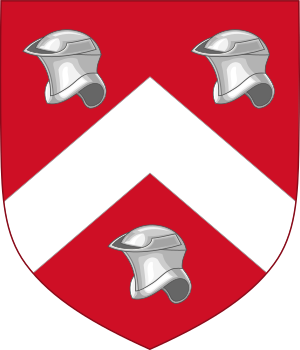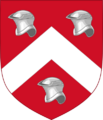Owen Tudor facts for kids
Quick facts for kids
Owen Tudor
|
|
|---|---|

Arms of Owen Tudor
|
|
| Full name |
Owen ap Maredudd ap Tudur
|
| Born | c. 1400 Anglesey, Wales |
| Died | 2 February 1461 |
| Buried | Greyfriars Church, Hereford, Herefordshire |
| Noble family | Tudor |
| Spouse | Catherine of Valois (m. 1428; d. 1437) |
| Issue |
|
| Father | Maredudd ap Tudur |
| Mother | Margaret ferch Dafydd |
Sir Owen Tudor (born around 1400, died February 2, 1461) was an important Welsh nobleman. He became the second husband of Queen Catherine of Valois (1401–1437). Catherine was the widow of King Henry V of England. Owen Tudor was also the grandfather of Henry VII, who later became king and started the famous Tudor dynasty.
Contents
Owen Tudor's Family Background
Owen Tudor came from a powerful family in Penmynydd on the Isle of Anglesey, Wales. His family, the Tudors of Penmynydd, had a long history. They were descendants of Ednyfed Fychan, a key Welsh official from the 1200s.
Owen's family was known for being very important in Wales. They served the Welsh princes and later the English king in Wales. However, they always remembered their Welsh roots. This loyalty led them to join the Glyndŵr Rising, a major Welsh rebellion against English rule. Owen's father, Maredudd ap Tudur, and his uncles were part of this revolt.
Owen Tudor's Early Life
Not much is known for sure about Owen Tudor's early life. This is partly because his family was involved in the Welsh rebellion. Many stories and myths grew around him. Some said he was a simple alehouse keeper's son. Others claimed he fought in the famous Battle of Agincourt.
What we do know is that after the Welsh rebellion, many Welshmen found jobs at the English royal court. In 1421, a person named 'Owen Meredith' joined the group of Sir Walter Hungerford, 1st Baron Hungerford. Sir Walter was a high-ranking official in the king's household.
Marriage to Queen Catherine of Valois
King Henry V of England died in 1422. This left his wife, Queen Catherine of Valois, as a widow. She first lived with her young son, King Henry VI. Later, she moved to Wallingford Castle.
At this time, there were rules about widowed queens remarrying. They needed permission from the king or Parliament. Queen Catherine later married Owen Tudor in secret. They had three sons together: Edmund, Jasper, and Edward.
Life After Queen Catherine's Death
After Queen Catherine died in 1437, Owen Tudor lost her protection. He was arrested and put in Newgate Prison. He managed to escape in 1438 but was caught again. He was then held at Windsor Castle.
However, in 1439, King Henry VI of England forgave Owen. He got his property back and was given a yearly payment. He also received a job at court. In 1442, King Henry VI welcomed his two half-brothers, Edmund and Jasper, to court. In 1452, they were given important titles: Edmund became the Earl of Richmond, and Jasper became the Earl of Pembroke. The king officially recognized them as his half-brothers.
Owen Tudor continued to be involved in court life. His yearly payment was increased in 1459. He and his son Jasper also took part in some political actions against those who opposed the king.
Owen Tudor's Death
Owen Tudor was one of the first people to die in the Wars of the Roses. This was a series of battles between two powerful English families, the House of Lancaster and the House of York.
In January 1461, Owen joined his son Jasper's army in Wales. This army was defeated at the Battle of Mortimer's Cross by Edward of York. On February 2, Owen Tudor was captured. He was then beheaded in Hereford. His head was placed on the market cross.
Owen Tudor had thought he would be imprisoned, not executed. Just before he died, he reportedly said that his head, which used to rest on Queen Catherine's lap, would now lie on the execution block. His body was buried in a church in Hereford.
Owen Tudor's Children
Owen Tudor and Queen Catherine of Valois had several children:
- Edmund (around 1430 – 1456) was born in either Hertfordshire or Bedfordshire. He became the 1st Earl of Richmond in 1452. Edmund married Margaret Beaufort. He died from the plague in 1456, just three months before his son was born. That son, Henry, later became the King of England and started the Tudor dynasty.
- Jasper (around 1431 – 1495) was born in Hatfield. He became the 1st Earl of Pembroke in 1452. Later, he was named a traitor in 1461. However, he became the 1st Duke of Bedford in 1485. Jasper had one daughter from another relationship, named Ellen Tudor.
- Edward Tudor: Very little is known about this child. Some historians believe he became a monk, but there is no clear record of him.
- Some sources also mention a daughter who became a nun, but this is not confirmed by other records.
Owen Tudor also had at least one child from another relationship:
- Sir David Owen was born in 1459. He became an important figure and is buried in Easebourne, near Midhurst.
Images for kids
See also
 In Spanish: Owen Tudor (1400-1461) para niños
In Spanish: Owen Tudor (1400-1461) para niños


